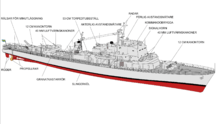Östergötland-class destroyer
 HMS Östergötland | |
| Class overview | |
|---|---|
| Builders: | Götaverken, Eriksbergs Mekaniska Verkstad, Kockums Mekaniska Verkstads AB |
| Operators: | Swedish Navy |
| Preceded by: | Halland class destroyer |
| Succeeded by: | None to date (As of March 2015) |
| In commission: | Sweden: 1958–1982 |
| Completed: | 4 |
| Retired: | 4 |
| Preserved: | 0 |
| General characteristics (Sweden)[1] | |
| Displacement: |
|
| Length: | 112 m (367 ft 5 in) |
| Beam: | 11.2 m (36 ft 9 in) |
| Draft: | 3.7 m (12 ft 2 in) |
| Propulsion: | 2 shaft geared turbines, 2 boilers, 47,000 hp (35,000 kW) |
| Speed: | 35 kn (65 km/h) |
| Range: | 3,000 nmi (6,000 km) at 20 knots (37 km/h) |
| Complement: | 244 |
| Armament: |
|
| Notes: | Ships of the class took part in a number of incidents and confrontations involving Soviet incursions into Swedish waters during the late 1970s and early 1980s, most notably the Whiskey on the rocks incident in 1981. |
The Östergötland class were a group of destroyers built for the Swedish Navy in the late 1950s. They were smaller and less capable than the preceding Halland class destroyers and were decommissioned in 1982. The class was to be the last destroyers to be built by Sweden in the 20th Century. They were sometimes referred to as Light destroyers.
Ships
| ship | Pennant number | builder | commissioned | fate |
|---|---|---|---|---|
| HMS Östergötland | J20 | Götaverken, Göteborg | 1958 | Decommissioned 1982, |
| HMS Södermanland | J21 | Eriksberg, Göteborg[lower-alpha 1] | 1958 | Decommissioned 1982 |
| HMS Gästrikland | J22 | Götaverken, Göteborg | 1959 | Decommissioned 1982 |
| HMS Hälsingland | J22 | Eriksberg, Göteborg | 1959 | Decommissioned 1982 |

The general layout of an Östergötland destroyer, prior to the class being modernised between 1963 and 1967

The Södermanland testing it's newly installed SeaCat launcher sometime during 1963. The linked CRBFD used a variant of the M4 radar manufactured by Hollandse Signaalapparaten.[2]
Notes
- ↑ In the case of the Södermanland, unlike her sister ship Hälsingland, Eriksbergs Mekaniska Verkstad just built the hull, with completion and fitting out done by Kockums Mekaniska Verkstads AB. The reasons for this are unclear, though it may possibly have been part of a work share agreement.
References
- ↑ Conway's All the World's Fighting Ships 1947-1995
- ↑ "SEACAT - The Guided Missile To Defend Small Ships" FLIGHT International, 5 September 1963, p. 442.
- Gardiner, Robert and Stephen Chumbley. Conway's All The World's Fighting Ships 1947–1995. Annapolis, Maryland, USA, 1995. ISBN 1-55750-132-7.
| ||||||||||
This article is issued from Wikipedia - version of the Friday, November 20, 2015. The text is available under the Creative Commons Attribution/Share Alike but additional terms may apply for the media files.